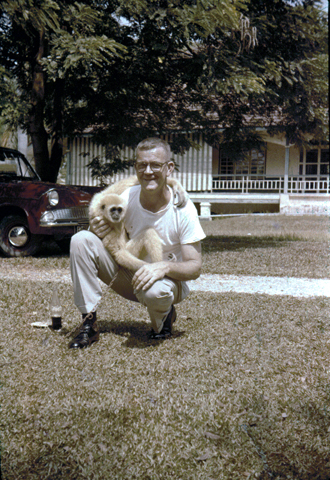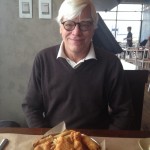I once interviewed a prominent ecologist for my doctoral research, whose partner told me, “You know, these [prominent ecologists], they all have really strong mothers, influential women that encouraged them to explore nature.” I liked this theory, though I didn’t have much proof to support it, so I thought better of mentioning it in my dissertation.
I bring this story up today only because I want to completely disavow any sort of similar claim that you may or may not imagine I am making with my title. In fact, once I realized that this was the post that I was writing, I was slightly embarrassed. You see, by pure chance, I have researched the work of a lot of scientists with sons.
The first was Carroll Williams, an insect physiologist whose work I ran across early in my doctoral career. In leading his lab at Harvard in the 1950s, he solved a small scientific mystery, a sort of biochemical whodunit. Whole generations of his insect subjects were mysteriously dying. They grew and grew, but never developed into mature adults, remaining outsized juveniles, unable to reproduce.

His sleuthing led him finally to the paper towels he used to line their petri-dish homes. But when he wrote to the manufacturer to ask for the makeup of the towels, the answer he received was simply this: “paper pulp.” Not one to be disheartened, Williams hypothesized that the trees used to make the pulp must produce chemicals that acted as hormone mimics, disrupting the development of his insect subjects—compounds that had likely evolved in response to insect feeding, as a form of “natural insecticide.” He even managed to isolate this substance and verify that it was responsible for the death of his experimental insects.
Williams’ fascination with “natural insecticides” was shared by the coevolutionary theorists at the core of my Ph.D. research, so when I learned that the Harvard University Archives held his collected papers, I was pretty excited to get a look at them. Typically, I seek out a scientist’s children when it proves impossible to locate the scientist’s papers in any archive, in the hopes that their family has stashed away boxes of letters and research notebooks in a nice dry attic somewhere. But in this case, while Williams’ papers were already conveniently deposited in an archive, I needed special familial permission to gain access to them. Luckily, I had the internet to help with own my sleuthing, and I tracked down one of Williams’ sons, Roger, who kindly sent Harvard notice that I could see his father’s papers.
Another scientist whose son I have contacted is Gottfried S. Fraenkel—again, an insect physiologist and a near contemporary of Williams. Fraenkel was far more interested in insect nutrition than in hormones, however. In fact, it was his interest in nutrition that brought me into contact with his son, Gideon, who has had a career as an organic chemist himself. I was revising a paper about Fraenkel the senior, starting with his work in the UK in the ‘30s and ‘40s on the molecules of nutrition. Later Fraenkel moved to the US, where he began to hypothesize about the evolution of insect feeding choices. But in 1946, a couple of years before he left the UK, Fraenkel contributed to a Fabian Society tract on agriculture, arguing vehemently against the capitalist conspiracy to foist white bread on an unsuspecting public. Using his favorite research subject, the confused flour beetle, Fraenkel had demonstrated that refined grain was nutritionally deficient. Even more significantly, he found that refortifying the bread with the nutrients removed in processing still produced a nutritionally inferior product—a very nice story in light of growing scientific consensus that vitamin supplementation may be fairly worthless (or worse!).
In other words, Fraenkel suggested—back in the 1940s—a fairly holistic concept which has seemed increasingly convincing in recent years: nutrients are healthful in the context of food, but a disembodied molecule (even when added back in to food) is of dubious value. The reductionist reliance on nutrients has not attracted a ton of media attention, though Michael Pollan wrote a nice piece on this topic some years ago (and I loved the molecular banana cover image for this piece!). Expect more coverage now, however; just today, NPR has rounded up recent research on the value of vitamins, which is well worth checking out.
But back to the sons of scientists! When I first wrote the paper on Fraenkel, I did not realize that he was instrumental in naming brown bread the National Loaf of Great Britain. In other words, there was a UK-government mandated insistence on whole wheat as early as the 1940s! (Yet, my kid’s nursery today serves white toast to preschoolers who otherwise would not even know that such an abomination exists…) And I only learned about this thanks to Gideon Fraenkel, who actually wrote a letter to the New York Times on the subject.
One son of an scientist, I am chagrined to admit, may have been unhappy with how I portrayed his father. Warm and welcoming when I was viewing his father’s correspondence, I never heard from him again after sending him a draft of the paper that examined some of his father’s work. This is certainly the biggest danger in interacting directly with a subject’s children; they naturally want to see their parent’s work only celebrated.

Most recently, when I traveled to Boston for the 2013 History of Science Society meeting, I was lucky enough to meet with the son of one of my current subjects. Don Eyles was a parasitologist working for the NIH in 1960 when he was accidentally infected with a malaria parasite that had been isolated from a Malaysian (or, rather, Malayan, at the time) macaque. Though the infection of humans with monkey malaria had, in truth, been known for decades, malariologists regarded the possibility as so remote that used little caution with the monkey malarias, even when working with heavily infected mosquitoes. Eyles was one of the first to learn that this was a mistake: What seemed like a meaningless mosquito bite while running an experiment became, for him, a case of malaria. And thus ensued three years of intensive NIH-funded lab and field research on a variety of monkey malarias and their mosquito vectors.
Admittedly, when I started searching for the children of Don Eyles, I immediately saw that his son—his namesake, in fact—lives in Boston. Eyles Jr. is an interesting person in his own right, having worked as programmer on the moon mission. The BBC referred to him as a “Beatnik” who put men on the moon. And here Eyles has written a paper about technical problems on the mission.
Meeting with him last month, I enjoyed my requisite Bostonian lobster lunch and gratefully received the gift of historical treasures from him. He lent me a very cool 1966 New York Times Magazine with a cover article on his father’s malaria research project. And he gave me a copy of the memoir of his fascinating mother, Mary Stipe Eyles, who was herself trained as a scientist and taught high school biology for many years. His mother and his two younger siblings were with Don Eyles Sr. when he tragically died of a heart attack in 1963, just as the family was about to return to the US from Malaysia.

Don Eyles Jr. (who even, by the way, attended my talk at the conference!) promises to put me in touch with his sister, one of the above-mentioned younger siblings, who lived in Malaysia with her family while her father pursued local monkey malarias. Check out photos of the family here.
I may finally have my chance to talk to the daughter of a scientist! And I have no doubt that she will be just as helpful and insightful as the very kind scientists’ sons who have kindly assisted me in the past!
Skip to content

